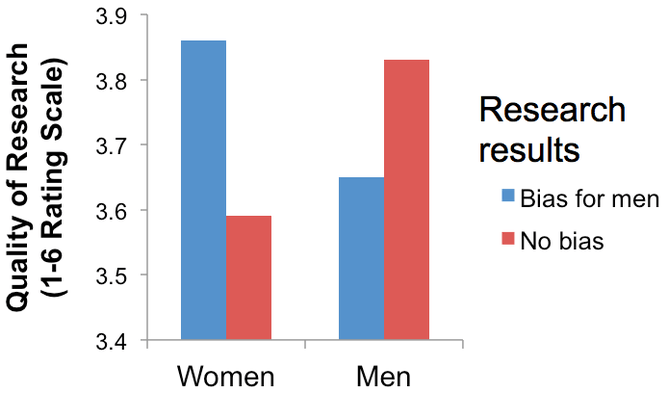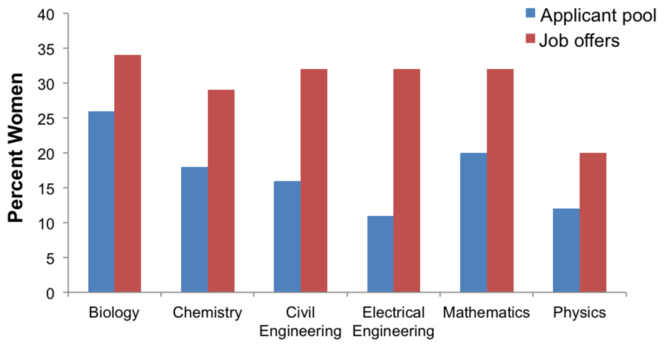Men and women biased about studies of STEM gender bias – in opposite directions

In 2012, shook the scientific community by showing that science faculty favor male college graduates over equally qualified women applying for lab manager positions. Though the study was rigorous, many .
"This report is JUNK science. There is no data here," said . Others saying, "In every competitive situation, with a few exceptions, the women I worked with were NOT competent."
Now, in Proceedings of National Academy of Sciences (PNAS) provides crucial clues about why some people were critical of the original finding – and other studies that have followed. The new study's authors reasoned that men especially might devalue the evidence because it threatens the legitimacy of their status in science, technology, engineering and mathematics (STEM) fields. Men might also be critical because of that gender bias is not a problem in STEM.
Assessing the original study
To test these ideas, the researchers recruited 205 people from the general public and 205 Montana State University tenure-track faculty. These participants read and then evaluated the abstract of the now-famous 2012 study also published in PNAS.
noted that
In a randomized double-blind study (n = 127), science faculty from research-intensive universities rated the application materials of a student—who was randomly assigned either a male or female name—for a laboratory manager position. Faculty participants rated the male applicant as significantly more competent and hireable than the (identical) female applicant.
Men rated the research quality of the abstract less favorably than did women in both samples. This gender gap was especially large for STEM faculty, potentially suggesting that evidence of bias might threaten men in STEM seeking to .
When reading these results, a male scientist might think, "oh my gosh…if we're going to fix this equality issue, that almost necessarily means that there's going to be fewer opportunities for men," said Ian Handley, lead author of the new PNAS paper and associate professor of psychology at Montana State. Handley suggested that discounting evidence more likely reflects a subtle, unconscious process than overt sexism.
The researchers also tested for gender bias towards the abstract's authors. Participants were randomly assigned to read an abstract identifying the first author's first name as either "Karen" or "Brian." Either way, "Karen's" and "Brian's" research were overall evaluated the same. In other words, the first author's perceived gender didn't affect what participants thought of the research itself.
This lack of author gender bias . Both and typically show little to no gender bias in peer review. However, are .
This evidence about mostly gender-fair peer review is encouraging. But men, especially those in STEM, are still overall more reluctant to accept the evidence of bias when it does exist. This reluctance might prevent efforts to change bias because men hold the majority of top positions in STEM. In 2010, for instance, men were 65% of full professors in , 76% in , and 92% in .
"We can't try to solve a problem if we don't know it exists," said Jessi Smith, professor of psychology at Montana State and co-author of the new PNAS study.
Women have their own biases
A third study tested how people respond to studies finding no bias. This addition is important because some facets of academia such as don't . Researchers therefore randomly assigned 303 participants from the general public to read an abstract that either reported bias favoring men or reported no bias.

Even though the research methods were identical across conditions, women rated the quality of the research lower when the abstract showed bias than if it didn't. Men showed the reverse pattern. So both genders were biased, but in opposite directions.
Fairly evaluating gender bias research
The results suggest challenges in fairly evaluating gender bias research. People may unintentionally ignore evidence if it conflicts with their social identities or prior beliefs. Special care should be taken to seek disconfirming evidence. For instance, the new paper made claims about "robust gender biases documented repeatedly," but could have also noted the about such claims.
The paper argues that "numerous experimental findings" provide "copious evidence" of gender bias. But studies have found mixed evidence. For instance, the paper notes showing bias against female psychology tenure-track applicants. But experiments conducted 15+ years later show . In fact, show a preference for female applicants in , not just .
These results collectively suggest some biases are weakening over time, consistent with . For instance, the bachelor's to PhD pipeline more women than men, as it did among college graduates in the 1970s.
This mixed literature tempers the paper's claims about strong gender bias. But obviously, the paper's central goal was not to systematically review literature on gender bias, but rather present studies of reactions to evidence of bias.
Communicating controversial research with caution
Understanding how bias varies can help target action and use limited resources wisely. Nevertheless, failures to carefully communicate this nuanced research can easily unravel progress.
In 2014, for instance, Cornell University professors Wendy Williams and Stephen Ceci wrote about of literature on women in academic science. The full-length review was rigorous and expansive in scope. But the op-ed was a disaster in science communication.
The NYT wrote the headline "Academic Science Isn't Sexist," which ignited . Ceci called the headline "sensationalistic" and "offensive" in an email to me. He explained the headline was inappropriate because their review, "reported some areas of sex differences (e.g., tenure being harder for women in biology)."
Ceci stands by the conclusion of "largely gender-fair outcomes for professors," but also agrees the exceptions are important. Based on the best current data, remaining challenges include , bias in and , and gender stereotypes about and . My own research also shows robust implicit stereotypes associating science with men, even in supposedly "gender-equal" nations like Sweden. The NYT op-ed should have done more to explicitly discuss these notable problems.
The new PNAS study shows that men, on average, are less likely to believe this evidence of gender bias where it exists. And that's a concern, considering men are the . But it's also a concern if the evidence of gender bias is overhyped. could make these fields or even make people less likely to believe evidence of bias when it does exist.
Pushing the debate forward
The new study affirms we all have bias to varying degrees. So no one should feel smug for being free of bias or impugn others because of it.
In my case, I should interrogate how my identity as a gay white male liberal academic shapes my judgments. I doubt I can ever be truly free of my biases. But I can help minimize them by seeking to learn from those with different views.
Progress in science requires actively engaging in and learning from debate with others, even if we may find their views offensive. Civil discussion can be challenging with controversial topics such as gender bias. But, to flourish, the science needs the debate.
More information: "Quality of evidence revealing subtle gender biases in science is in the eye of the beholder." PNAS 2015 ; published ahead of print October 12, 2015,
Journal information: Proceedings of the National Academy of Sciences
Source: The Conversation
This story is published courtesy of (under Creative Commons-Attribution/No derivatives).
![]()


















